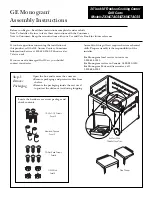
page 6
OPERATION
1.
For
drilling
, turn the hammer-drill lever towards the drill symbol .
2.
For
hammer-drilling
, turn the hammer-drill lever towards the
hammer symbol .
NOTE:
To engage the hammering mechanism, maintain pressure on
the bit. When pressure on the bit is released, the hammering action
will stop.
Using Forward/Reverse Lever (Fig. 6)
The forward/reverse lever can only be adjusted when the trigger is not
pressed. Always allow the motor to come to a complete stop before
using the forward/reverse lever.
Selecting Action (Fig. 5)
MILWAUKEE Hammer-Drills have two settings: drilling and
hammer-drilling.
Fig. 6
Forward
Reverse
1.
For
forward
(clockwise) rotation, push the forward/reverse lever to
the left (when viewed from the back of the tool) as shown.
2.
For
reverse
(counterclockwise) rotation, push the forward/reverse
lever to the right (when viewed from the back of the tool) as shown.
Allow the motor to come to a full stop before reversing.
NOTE:
When hammer-drilling, use the tool in forward rotation (clock-
wise) only.
Selecting Speed
The speed can be changed when the tool is at a complete stop or running
under no load.
1.
For
low
speed (up to 1350 rpm), turn the speed selector to
position 1.
2.
For
high
speed (up to 2500 rpm), turn the speed selector to
position 2.
Starting, Stopping & Controlling Speed
1.
To
start
the tool, pull trigger.
2.
To
stop
the tool, release trigger.
3.
To vary the speed, increase or decrease pressure to trigger. The
further the trigger is pulled, the greater the speed.
Operating
Position the tool, grasp the handles firmly and pull the trigger. Always
hold the tool securely using both handles and maintain control. This tool
has been designed to achieve top performance with only moderate pres-
sure. Let the tool do the work.
If the speed begins to drop off when drilling deep holes, pull the bit par-
tially out of the hole while the tool is running to help clear dust. Do not
use water to settle the dust since it will clog the bit flutes and tend to
make the bit bind in the hole.
APPLICATIONS
Drilling in Wood, Composition Materials and Plastic
When drilling in wood, composition materials and plastic, select the drill
operating mode. Start the drill slowly, gradually increasing speed as you
drill. Select low speeds for plastics with a low melting point.
Drilling in Metal
When drilling in metal, select the drill operating mode. Use high speed
steel twist drills or hole saws. Use a center punch to start the hole.
Lubricate drill bits with cutting oil when drilling in iron or steel. Use a
To reduce the risk of electric shock,
check work area for hidden pipes and
wires before drilling.
WARNING!
coolant when drilling in nonferrous metals such as copper, brass or
aluminum. Back the material to prevent binding and distortion on break-
through.
Drilling in Masonry
When drilling in masonry, select the hammer-drill operating mode. Use
high speed carbide-tipped bits. Drilling soft masonry materials such as
cinder block requires little pressure. Hard materials like concrete require
more pressure. A smooth, even flow of dust indicates the proper drilling
rate. Do not let the bit spin in the hole without cutting. Do not use water
to settle dust or to cool bit. Do not attempt to drill through steel reinforcing
rods. Both actions will damage the carbide.
WARNING!
To reduce the risk of injury, wear safety goggles or
glasses with side shields. Unplug the tool before
changing accessories or making adjustments.
Selector Lever
Fig. 5






































